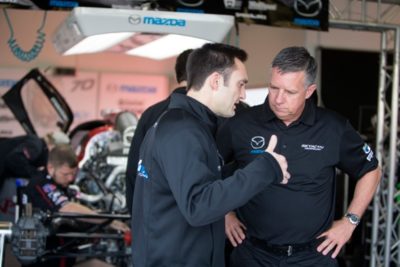Being able to properly explain what the car is doing – to your crew chief or yourself – is the key to making the car better, says Tom Long.
Driver feedback is often thought of as the information a racer gives back to his team – to the engineers, to the crew chief, to all the people that will be working to make the car better for the next session.
The majority of racers, though, don’t have a cadre of technically skilled people ready to descend on the car when it arrives in the paddock. The typical club racer may have a hired crew chief, but often it’s a family member or buddy. Those who rent a car or have their car prepped through an arrive-and-drive program will have more resources at their disposal. But in many cases the driver is also the engineer, the crew chief, the mechanic and the caterer. In every one of those instances, though, driver feedback is important – even if it’s just to yourself.
“Make sure you’re prepared and have a notepad ready when you get out of the car to be able to debrief yourself,” says Tom Long, driver of the Mazda SKYACTIV Prototype in the TUDOR United SportsCar Championship, an accomplished Miata racer and a professional driving coach. “Note how that session went and what it is you want to focus on. Say you jot down four or five things down after a session; you can then prioritize them and review them, whether you’re reviewing them yourself or with a crew chief. It’s important to prioritize – ask yourself, ‘What do I need to go faster and what is keeping me from having more confidence?’”
That last question is pretty much the point of giving good feedback, no matter where that feedback is going. Long says that, as a driver, if one has confidence in the equipment and oneself, the driver will give a better performance.
From there, the questions to ask yourself are pretty straightforward. “What would be the one thing you would do to the car to go faster? What’s holding you up from being able to go quicker through that corner or brake later? Those types of questions make it easier to triage the information of all the options of what to potentially do to the car – what direction to go, what changes to make. They break it down to something simple and allow you to focus on that,” he says.
Those questions are not always easy to answer, though. Sometimes it’s just a feeling in the gut that something isn’t right. That’s where some deeper analysis must kick in.
“There are a couple of ways to think about it, two things specifically,” explains Long. “First, try to break it down to where in the corner or where on the track it’s happening. Is it corner entry? Is it in the middle of the corner or out in the exit? Does it only happen in right-hand corners or left-hand corners? Think about the weight dynamics of it. When something doesn’t feel right, try to picture where the weight is in the car; that would give you at least a direction to go in. As an example, if the car is understeering in the middle of the corner, where’s the weight? Are you applying the throttle, causing the nose to lift up and the weight to go to the back of the car?”
These questions will help you give good feedback to an engineer, crew chief, buddy or whoever might be lending a hand – including yourself. Once the facts are in hand and you know what, when, where and how the car is doing what it’s doing, the problem becomes much easier to solve.


 ACCESSIBILITY
ACCESSIBILITY